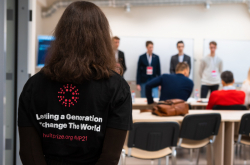What is MerkleBot engaged in right now?
Our company develops a core technology that allows users to access their equipment remotely. At the same time, it creates secure control channels for devices which support the Robot Operating System technology. We entered the Techstars accelerator program thanks to three pilot projects. One of them is about remote access to the Spot robot. It’s used in educational activities, for example, ITMO students can learn how to code and control the robot dog. In the future, we would like to apply this technology in other fields besides education.
The second case is related to professional telescopes, in particular the ones located in Chile. When the sky is clear and stars are visible, we give users access to the telescope, they choose an object in the sky and take a picture of it. Then they can create an NFT token with the photo. We have several customers each day.
The last pilot project has to do with smart leasing of industrial equipment to small and mid-size businesses. We have customers among industrial integrators who install the equipment in their facilities, we provide a loan for purchasing and installing it, and then calculate the credit rate based on how intensively this equipment is used. This allows companies who took out the loan to stay afloat, as they can predict the cost of leasing and avoid overpaying in periods when they barely use the equipment.
How does Techstar’s Filecoin differ from other international counterparts?
There are four top money-making accelerators: 500 Startups, Y Combinator, AngelPad, and Techstars. Each of them helped unicorn companies, such as Airbnb, GitLab, Dropbox, etc. The first two organizations are mostly engaged in quickly scalable solutions, programs, and services, whereas Techstars is an accelerator that supports engineering startups as well. Software projects are quite flexible, fast, and easily scalable, but hardware has to do with actual equipment and requires more money, time, and risk management.
The accelerator program that we went through was created jointly with affiliated organizations and Filecoin, a decentralized platform for data storage, which is an alternative to cloud storages like the one by Amazon. Its users can rent free space on their hard drives and get paid for that with the Filecoin (FIL) cryptocurrency.
How hard was it to join Techstars and Filecoin?
Before we entered Techstars, Sergey Lonshakov, Vitaly Bulatov (co-founders of MerkleBot – Ed.), and I took part in various Russian events, such as GenerationS. Back then, we worked on another project called Drone Employee. But in 2017 we started to participate in international conferences such as ReadWhite, InterDrone and hackathons like ETH San Francisco Hackathon; plus we entered the global market. In early 2019, we reconfigured Drone Employee and turned it into a project on drone control called Distributed Sky.
It was extremely difficult to enter Techstars. It took us about five years and we were accepted on our fourth try. When we applied with the Distributed Sky project for the first time in 2018, the organizers said they couldn't accept us because of the startup’s investor who wasn’t able to actively work on the company’s development. That’s why we reconfigured the application again and starting with 2019, applied with MerkleBot (you can learn more about this project here). However, we still weren’t accepted straight away. At first, we only had the technology, then we supplemented it by a business model and irregular sales, but this wasn't enough.
In 2021, on our fourth attempt, we had several integrations at factories and daily sales of our solutions. This helped us make it through the selection. Once we’d signed our first six-figure deals, joining the accelerator became possible. If you apply and your sales are around $200, which can be scaled up to $20,000, this won’t attract much attention, but when it comes to hundreds of thousands that can be turned into millions – that’s another thing.
Filecoin is a pretty closed contest and not all the information is available but when we spoke to Babak Kia, one of the MerkleBot co-founders, who acts as mentor and judge at similar contests, we found out that over a 100 companies took part in the selection process. We were accepted for the hybrid program. At the first stage, which takes place right now, the companies meet mentors and potential partners of the Techstars community and attend online consultations, but some of the meetings will take place only on-site in Seattle. Our CEO Vitaly Bulatov, who’s located in the US, will attend them. By the end of the accelerator, the organizers will hold a demo day, where everyone should present their solutions, business models, and financial perspectives. This will have an impact on future investments.
What do you expect from the accelerator and how do you want to develop MerkleBot?
All the startups receive funding – several hundreds of thousands of dollars – for 10% of their company’s share. For us, this accelerator is an opportunity to find clients. We have our first sales and now we need to find a way to scale them up, as well as figure out who exactly we can help and how we can do it.
For now, making sales is our only task for the future. All startups focus on that; if you have a scalable high-tech business and you want to improve sales, you should join an acceleration program. In other cases, you can apply for preaccelerators or look for business angels and specialized communities.
Russian startups can’t participate in international accelerators right now. What would you recommend to those who wished they could join?
That’s true, Russian companies can’t participate right now, but it’s possible to create a foreign project. Or, if you prefer to wait for the moment when participating in international programs will become available again, you shouldn’t just sit around and waste your time.
For example, find a person who made it through Techstars and invite them to join your team. But of course, you should know well what kind of a project you’re working on, what its target audience is, and what problems it solves. This is vital. I’d also recommend joining a community, communicating more, and attending specialized events. Other than that – be patient and accept that it would take you around five years to make an engineering startup work and another three years to recoup the development cost. It’s a really long process. When it comes to software startups – get ready for around three years of hard work. Then you should evaluate your project – a product, technology, or community – and look for suitable forms of investment.
You should also learn how to fill out the applications for accelerators. Experts first check out the team and see if its members are qualified enough to place their product on the market, how old they are, and whether they can spend at least 20 hours per week on the startup. If you don’t have at least two people who can fully immerse themselves in the work, it’s a bad sign. Plus, the technology itself, its prospective place on the market and the distribution of your company’s shares are also important.






